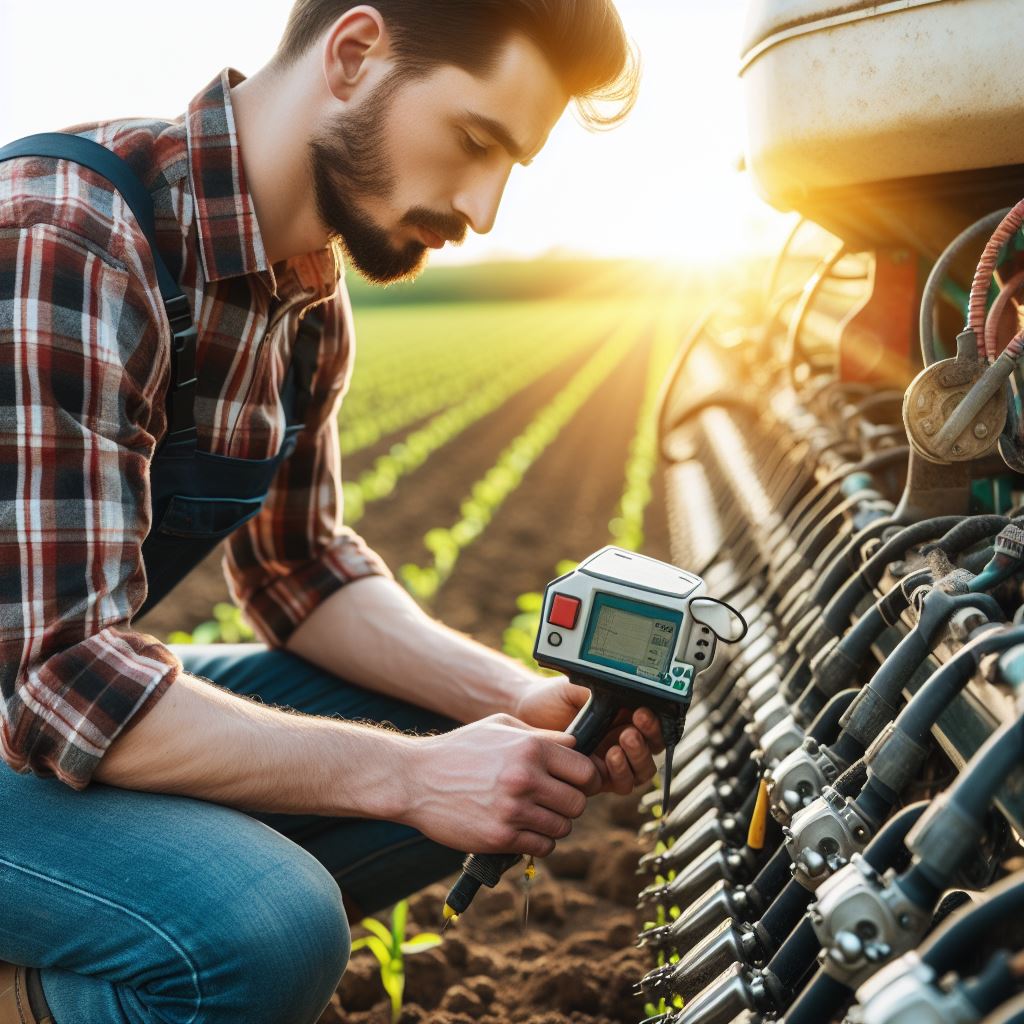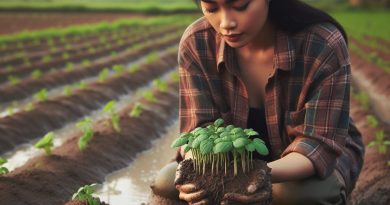Precision Planting for Success
Last Updated on March 2, 2024
Introduction
A. Brief Overview of Precision Planting
Precision planting involves using advanced technologies to precisely place seeds in the soil, optimizing spacing, depth, and timing for each seed.
B. Importance of Precision Planting for Successful Farming
- Maximizes Yield: Ensures each seed has ideal conditions for germination, leading to higher crop yields.
- Resource Efficiency: Reduces seed and fertilizer wastage, saving costs and minimizing environmental impact.
- Uniform Crop Development: Helps achieve consistent plant growth, leading to easier crop management and higher-quality produce.
- Time Management: Allows farmers to plant efficiently, optimizing their time during the busy planting season.
- Data-Driven Decisions: Provides valuable data on planting practices, enabling farmers to make informed decisions for future seasons.
- Adaptability: Precision planting technologies can be adapted to various crops and field conditions, enhancing their versatility.
- Competitive Advantage: Farmers adopting precision planting gain a competitive edge through improved yields and resource management.
In essence, precision planting is essential for modern agriculture, offering numerous benefits that contribute to successful farming operations.
Benefits of Precision Planting
When it comes to precision planting, there are numerous benefits that farmers can reap.
In this section, we will explore the advantages of implementing precision planting in agricultural practices.
A. Increased yield potential
Precision planting allows farmers to optimize their planting process, resulting in increased yield potential.
By ensuring accurate seed placement and spacing, crops can grow more efficiently and achieve higher yields.
Through technologies like GPS guidance systems and variable rate planting, farmers can precisely plant seeds at the right depth and distance.
This precision minimizes competition among plants, reduces stress, and ultimately maximizes the yield potential of each crop.
B. Better use of resources
Precision planting enables farmers to make the best use of their resources, such as seeds, fertilizers, and water.
By ensuring proper seed placement, farmers can minimize waste and optimize resource efficiency.
With precise planting, fewer seeds are wasted due to overlapping or inadequate spacing.
By planting seeds at the right depth, seed-to-soil contact is improved, enhancing germination rates and reducing the need for excess seeds.
Farmers can also customize the amount of fertilizer and water applied, based on specific soil and crop needs.
This targeted approach avoids over-application, leading to cost savings and environmental benefits.
C. Improved crop uniformity
Precision planting promotes better crop uniformity, resulting in more consistent plant growth and maturity.
Uniform crop development allows for effective management practices, such as pesticide application and harvest timing.
By planting seeds at precise depths and distances, crops emerge uniformly, reducing variations in growth stages.
This uniformity ensures that all plants receive sufficient light, nutrients, and water, contributing to healthier and more synchronized crop growth.
D. Enhanced seed placement accuracy
Precision planting technologies like pneumatic planters and automated systems enhance seed placement accuracy.
These advanced tools ensure that seeds are planted at the desired depth and with optimal seed-to-soil contact.
Accurate seed placement is crucial for good germination and strong plant establishment.
When seeds are placed too shallow or too deep, they may not receive adequate moisture, affecting germination rates and early growth.
Moreover, precise seed placement allows for better utilization of soil moisture and nutrients.
By placing seeds in the optimal soil environment, plants can easily access vital resources, leading to healthier and more vigorous crop development.
In fact, precision planting offers several benefits to farmers.
By increasing yield potential, improving resource efficiency, enhancing crop uniformity, and promoting accurate seed placement, precision planting plays a crucial role in optimizing agricultural practices.
Embracing precision planting technologies can pave the way for more sustainable and successful farming operations.
Key Components of Precision Planting
A. High-tech planting equipment
- High-tech planting equipment is a vital component of precision planting systems.
- These equipment are designed to provide accurate and consistent seed placement in the soil.
- Features such as GPS guidance and variable rate technology ensure precise seed placement.
- Integrated sensors and control systems enable real-time monitoring and adjustment of planting parameters.
- High-tech planting equipment also includes advanced planter units and row cleaners for optimal seed-to-soil contact.
- These equipment enhance planting efficiency and help achieve uniform emergence, leading to better crop yield.
B. Advanced seed meters and singulation mechanisms
- Precision planting relies on advanced seed meters and singulation mechanisms for accurate seed spacing.
- Seed meters ensure consistent and precise seed drop by controlling seed flow.
- Singulation mechanisms separate seeds to prevent skips and doubles, ensuring even seed spacing.
- Innovative singulation technologies use vacuums, brushes, or mechanical mechanisms to achieve optimal spacing.
- These mechanisms are designed to handle various seed sizes and types, providing flexibility for different crops.
- Advanced seed meters and singulation mechanisms play a crucial role in achieving high planting accuracy.
C. Precision planting software
- Precision planting software is a key component for optimizing planting operations.
- This software utilizes data analysis, satellite imagery, and historical yield maps to optimize planting decisions.
- It helps determine the ideal planting population, seed variety, and input placement for each field area.
- Precision planting software integrates with planting equipment to automatically adjust planting parameters based on field conditions.
- It provides real-time feedback and data visualization, enabling farmers to make informed decisions.
- By leveraging precision planting software, farmers can maximize their yield potential and reduce input costs.
D. Automated adjustments and control systems
- Automated adjustments and control systems are integral to precision planting technology.
- These systems enable real-time adjustments of planting depth, downforce, and spacing as conditions change.
- By automatically adapting to varying field conditions, farmers can achieve consistent seed placement throughout the field.
- Automated downforce systems optimize seed-to-soil contact by adjusting downforce pressure based on soil moisture and compaction levels.
- Precision planting control systems synchronize multiple planter units to ensure accurate and synchronized planting.
- These automated adjustments and control systems enhance planting precision and efficiency, leading to improved crop performance.
In general, precision planting encompasses various key components that work together to achieve accurate and efficient seed placement.
High-tech planting equipment, advanced seed meters, and singulation mechanisms ensure precise seed spacing.
Precision planting software optimizes planting decisions based on field data. Automated adjustments and control systems adapt to changing field conditions.
By leveraging these components, farmers can maximize their yield potential and improve overall crop productivity.
Steps to Achieve Precision Planting
A. Field scouting and soil analysis
Field scouting and soil analysis are crucial steps in achieving precision planting.
By carefully examining the field and analyzing the soil, farmers can gather important information that will inform their planting decisions.
During field scouting, farmers assess various factors such as topography, pest presence, and weed infestation.
This allows them to identify potential challenges and implement strategies to overcome them.
Additionally, field scouting helps farmers determine soil moisture levels, which can affect plant growth and development.
Soil analysis further aids in precision planting as it provides essential information about soil fertility and nutrient content.
By conducting soil tests, farmers can identify nutrient deficiencies or excesses and make appropriate adjustments. This ensures optimal plant growth and maximizes yield potential.
B. Proper calibration of planting equipment
Planting equipment calibration is a critical step towards achieving precision planting.
It involves fine-tuning the equipment to ensure accurate and consistent seed placement.
Farmers need to calibrate their planting equipment based on seed size, shape, and weight.
Improper calibration can result in uneven seed spacing, leading to uneven crop emergence. This can negatively impact yield potential and crop uniformity.
Proper calibration also involves adjusting the planting depth to match the specific requirements of the chosen seed varieties.
Different seeds have different needs, and by calibrating the equipment accordingly, farmers can optimize plant growth and maximize yield potential.
C. Selection of appropriate seed varieties
Selecting the right seed varieties is essential for precision planting.
Farmers must consider various factors such as climate, soil conditions, and pest resistance when choosing seeds.
Crop-specific seeds that are bred for local conditions are more likely to thrive and produce higher yields.
Additionally, selecting seeds with traits that are resistant to prevalent pests and diseases can reduce the need for chemical interventions and promote sustainable farming practices.
When selecting seed varieties, farmers should also consider the desired end-use of the crop.
Different varieties may have different qualities important for specific markets, such as taste or texture.
D. Consideration of planting depth and spacing
To achieve precision planting, farmers must carefully consider planting depth and spacing.
This ensures optimal root development, nutrient uptake, and overall plant health.
Planting depth should be determined based on soil moisture levels and seed size.
Planting too shallow can expose seeds to drying out, while planting too deep can hinder germination.
By finding the right balance, farmers can enhance seedling emergence and promote uniform crop growth.
Proper spacing of seeds is equally important. Insufficient spacing leads to overcrowding, competition for resources, and reduced yields.
Excessive spacing, on the other hand, can result in wasted land and limited productivity.
Farmers must find the ideal spacing to optimize plant growth and achieve maximum yield potential.
In all, precision planting is essential for maximizing crop yields and ensuring sustainable farming practices.
By following the steps of field scouting and soil analysis, proper calibration of planting equipment, selecting appropriate seed varieties, and considering planting depth and spacing, farmers can achieve precision in their planting practices.
This results in healthier crops, higher yields, and increased overall farm productivity.
Best Practices for Precision Planting
Achieving success in precision planting requires adopting certain best practices to ensure optimal equipment performance, accurate planting, and informed decision-making.
Here are some key practices to consider:
A. Maintenance and Timely Inspection of Equipment
- Regularly inspect and maintain planting equipment to identify and address any potential issues.
- Check for worn-out parts, damaged sensors, and clogged tubes or hoses that may affect performance.
- Ensure proper calibration of planting equipment to achieve accurate seed placement and spacing.
- Replace worn or malfunctioning components promptly to avoid compromising planting precision.
B. Regular Monitoring and Adjustment During Planting
- Monitor planting performance continuously, checking for any deviations or inconsistencies.
- Adjust planting equipment settings as needed to account for varying soil conditions and seed varieties.
- Monitor seed singulation and spacing accuracy to maximize crop uniformity and yield potential.
- Make in-season adjustments for population rates or row spacing based on crop stand counts and yield potential.
C. Utilizing Data and Analytics for Decision-Making
- Collect and analyze data from planting operations to identify patterns and insights for future plantings.
- Utilize precision planting technologies to capture data on seed depth, spacing, and emergence rates.
- Leverage GPS and yield monitoring systems to track and evaluate field performance and profitability.
- Analyze historical data and yield maps to inform seed selection, planting rates, and variable rate prescriptions.
D. Continuous Learning and Staying Updated on New Technologies
- Stay informed about the latest advancements in precision planting technologies and equipment.
- Participate in training programs or workshops to enhance knowledge and skills in precision planting.
- Engage with industry experts, agronomists, and fellow farmers to exchange experiences and best practices.
- Attend conferences and exhibitions to explore new technologies and innovative solutions for precision planting.
By following these best practices, farmers can optimize their precision planting efforts, improve crop yields, and maximize return on investment.
Read: Pest Control in Sustainable Farming

Success Stories and Case Studies
A. Real-life examples of farms benefitting from precision planting
Precision planting has revolutionized farming practices across America, delivering remarkable results for farmers.
Here are some inspiring success stories:
- Increased Yield: Farmer John from Iowa adopted precision planting on his cornfields. He witnessed a 15% increase in yield in just one season.
- Cost Reduction: The Smith family farm in Nebraska saw a significant reduction in seed wastage, saving up to 20% on seed costs annually.
- Improved Efficiency: Farmer Sarah in Illinois found that precision planting reduced her planting time by 30%, allowing her to focus on other farm operations.
- Enhanced Crop Quality: The Johnson farm in Kansas noticed a remarkable improvement in crop uniformity, leading to better quality produce.
- Weed Control: Precision planting helped the Brown farm in Missouri to plant seeds at optimal depths, reducing weed competition and herbicide use by 25%.
- Water Conservation: In arid regions like California, precision planting helped the Garcia farm reduce water usage by 30% while maintaining crop yield.
B. Quantifiable improvements in crop productivity and profitability
The adoption of precision planting technology has not only increased crop productivity but also improved profitability for farmers nationwide:
- Yield Increase: On average, farms using precision planting have seen a 10-20% increase in crop yields, translating to higher profits.
- Cost Savings: Precision planting allows farmers to optimize input use, leading to savings of up to $20 per acre on fertilizers and pesticides.
- Time Efficiency: With precise planting techniques, farmers can cover more ground in less time, increasing overall farm efficiency and profitability.
- Market Advantage: Farmers using precision planting methods have a competitive edge in the market, commanding premium prices for their high-quality produce.
- Sustainable Practices: By reducing input wastage and improving crop management, precision planting promotes sustainable farming practices, attracting environmentally conscious consumers.
These success stories and quantifiable improvements demonstrate the significant impact of precision planting on American farms, making it a cornerstone of modern agricultural practices.
Read: Diverse Crops for Healthier Soil
Discover More: Soil Testing Before Planting
Find Out More: Sustainable Crop Management 101
Gain More Insights: Balancing Soil Nutrients for Crops
Challenges and Limitations of Precision Planting
Achieving precision planting for success in modern agriculture comes with its own set of challenges and limitations.
While the benefits of precision planting are undeniable, farmers and agricultural professionals must understand and address these obstacles to fully leverage this technology.
A. Initial Investment Costs
- Implementing precision planting technology requires a significant initial investment in specialized equipment and software.
- High costs of precision planters, sensors, monitors, and GPS systems may be a barrier for some farmers.
- However, it is crucial to consider the long-term return on investment this technology can provide.
- The increased yield potential, reduced inputs, and improved efficiency can offset the initial expenses.
B. Technical Complexities and Learning Curve
- Precision planting involves advanced technological systems that may be complex for farmers to understand and operate.
- Farmers must invest time in learning to operate and calibrate the precision planting equipment accurately.
- The learning curve associated with precision planting technology can be steep, requiring patience and commitment.
- However, agricultural training programs and educational resources are available to support farmers in adopting this technology.
C. Compatibility Issues with Existing Equipment
- Integrating precision planting technology with existing farm equipment can present compatibility challenges.
- Some older farm machinery may not be compatible with the advanced systems and interfaces of precision planters.
- Modifications or upgrades to existing equipment may be necessary to ensure seamless integration.
- It is essential for farmers to assess the compatibility of their machinery and plan accordingly for successful implementation.
D. Environmental Concerns and Sustainability Considerations
- While precision planting can offer numerous benefits, environmental concerns and sustainability must not be overlooked.
- Improper usage or excessive reliance on precision planting technology can lead to overuse of resources.
- Water contamination, soil erosion, and loss of biodiversity can occur if not managed responsibly.
- Farmers should strike a balance between precision planting and sustainable farming practices to minimize these risks.
- Regulatory compliance and adherence to environmental stewardship guidelines are crucial for long-term success.
Despite the challenges and limitations, precision planting holds immense potential for transforming modern agriculture.
By understanding and addressing the initial investment costs, technical complexities, compatibility issues, and environmental concerns, farmers can overcome these obstacles.
Training and education programs that equip farmers with the knowledge and skills to effectively utilize precision planting technology can further drive its adoption.
Ultimately, precision planting offers the opportunity to maximize yields, optimize resource utilization, and contribute to a more sustainable agricultural future.
Read: Integrated Pest Management for Crops
Gain More Insights: Maximizing Yield with Minimal Water Use
Future of Precision Planting
A. Integration with other farming technologies (e.g., IoT, drones)
Precision planting has a bright future as it continues to integrate with other farming technologies.
With the rise of the Internet of Things (IoT) and drones in agriculture, precision planting can harness their capabilities to enhance crop productivity and efficiency.
IoT devices can enable real-time monitoring of soil conditions, weather patterns, and crop health.
By collecting and analyzing data from various sensors, precision planting systems can adjust planting strategies based on accurate and up-to-date information.
This integration can optimize seed placement, spacing, and depth for better plant growth.
Drones, equipped with high-resolution cameras and advanced imaging technology, can capture aerial images of the fields.
These images provide valuable insights into plant health, nutrient deficiencies, and weed growth.
Precision planting can use this data to make informed decisions about seed placement, ensuring each plant receives the necessary resources for optimal growth.
Furthermore, the combination of precision planting and drone technology can enable targeted spraying, reducing the need for excessive pesticide use.
Drones can precisely identify plant diseases or pests and deliver targeted treatments, minimizing environmental impact and improving overall crop health.
B. Advancements in precision planting equipment and software
The future of precision planting heavily relies on advancements in equipment and software.
Manufacturers are constantly developing innovative tools and technologies to enhance planting accuracy and efficiency.
New precision planting equipment incorporates cutting-edge sensors and actuators, enabling more precise control over seed placement and planting depth.
As technology evolves, these machines will become even more sophisticated, allowing farmers to achieve higher levels of precision and consistency.
Software plays a crucial role in the success of precision planting systems. With advanced algorithms and machine learning capabilities, software can analyze vast amounts of data and generate actionable insights.
These insights can help farmers optimize planting strategies, improve crop yield, and reduce resource waste.
Additionally, software advancements in data integration and analysis facilitate seamless communication between precision planting equipment and other farming technologies.
Integration with farm management systems enables farmers to efficiently plan and execute planting operations, monitor progress, and make informed decisions in real-time.
C. Potential for autonomous planting systems
The future of precision planting also holds the potential for autonomous planting systems.
With the rapid development of autonomous vehicles and robotics, it is conceivable that fully autonomous planting machines may become a reality.
Autonomous planting systems will revolutionize agriculture by eliminating the need for human intervention during planting operations.
These machines will be equipped with advanced sensors, artificial intelligence algorithms, and GPS technology to autonomously navigate the fields, identify optimal planting locations, and precisely place seeds in the soil.
By removing human error and fatigue from the equation, autonomous planting systems can deliver consistent, accurate, and efficient planting results.
Farmers will be able to manage larger areas of land with ease, increasing productivity and reducing labor costs.
Moreover, autonomous planting systems can be integrated with other farming technologies, such as drones and IoT devices, to further enhance planting precision and optimize resource allocation.
This integration will create a seamless and interconnected ecosystem where different technologies work together towards a common goal – maximizing crop yield while minimizing environmental impact.
Generally, the future of precision planting looks promising. Integration with other farming technologies, advancements in equipment and software, and the potential for autonomous planting systems all contribute to a more efficient, productive, and sustainable agriculture industry.
As technology continues to evolve, precision planting will play a vital role in ensuring food security and meeting the demands of a growing global population.
Read: Composting: Organic Nutrient Powerhouse
Conclusion
A. Recap of the importance and benefits of precision planting
Precision planting plays a significant role in maximizing crop productivity and optimizing yields.
By ensuring accurate seed placement, seed-to-soil contact, and consistent plant spacing, farmers can expect better emergence rates, improved nutrient uptake, and reduced competition among plants for resources.
B. Encouragement for farmers to explore and adopt precision planting techniques
For farmers seeking to enhance their farming practices, precision planting offers a range of benefits.
By investing in modern equipment, such as seed meters, variable-rate planters, and precision guidance systems, farmers can experience improved crop uniformity, reduced input costs, and increased profitability.
Exploring precision planting techniques can lead to better field management and long-term sustainability.
C. Final thoughts on the future potential of precision planting
As technology continues to advance, precision planting will play an even more critical role in agriculture.
Innovations in sensor technology, data analytics, and autonomous machinery will further refine precision planting techniques, allowing farmers to achieve unprecedented levels of accuracy and efficiency.
The future holds immense potential for precision planting to contribute to global food security and environmental sustainability.
Precision planting is not just a farming practice; it is a pathway to success. Its importance and benefits cannot be overstated.
Farmers should explore and adopt precision planting techniques to optimize crop production, increase profitability, and pave the way for a sustainable and prosperous future in agriculture.


